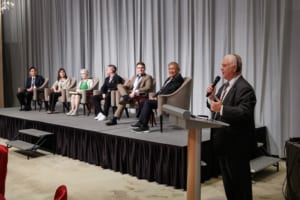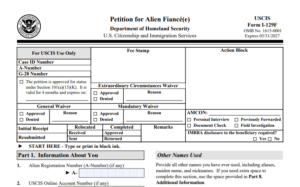Diện Thị thực Định cư Ưu tiên Thứ hai dựa trên Việc làm (EB-2) dành cho những người có bằng cấp cao hoặc những người có năng lực đặc biệt trong lĩnh vực khoa học, nghệ thuật hoặc kinh doanh.
Lợi ích của thị thực định cư EB-2
- Đủ điều kiện để quý khách cùng các thành viên gia đình được thường trú hợp pháp.
- Được làm việc trong lĩnh vực chuyên môn của quý khách tại Hoa Kỳ.
- Con cái được nhận vào các trường đại học công lập với mức học phí tương đương với cư dân/công dân Hoa Kỳ.
- Có quyền bảo lãnh người thân qua Mỹ thường trú.
- Có thể đủ điều kiện để được nhập quốc tịch Hoa Kỳ sau 5 năm là thường trú nhân.
Các tiêu chí đủ điều kiện xin thị thực EB-2
Chuyên gia có bằng cấp cao
Để đủ điều kiện trở thành chuyên gia có bằng cấp cao, người nộp đơn phải có:
1) Học bạ gốc chứng minh người đó đã có bằng cấp nâng cao tại Hoa Kỳ hoặc bằng cấp có giá trị tương đương tại nước ngoài; hoặc
2) Học bạ gốc chứng minh người đó có bằng cử nhân được cấp bởi Hoa Kỳ hoặc bằng cấp có giá trị tương đương tại nước ngoài và bằng chứng chứng minh đương đơn có ít nhất 5 năm kinh nghiệm chuyên ngành sau khi có bằng cử nhân.
Khả năng đặc biệt trong Khoa học, Nghệ thuật hoặc Kinh doanh
Để đủ điều kiện trở thành người có năng lực đặc biệt trong khoa học, nghệ thuật hoặc kinh doanh, người nộp đơn phải sở hữu ít nhất 3 trong số những điều sau:
1) Học bạ gốc cho thấy người nộp đơn có bằng cấp, chứng chỉ, chứng nhận hoặc giải thưởng tương tự từ một tổ chức giáo dục đại học liên quan đến lĩnh vực có năng lực đặc biệt;
2) Thư giới thiệu từ người sử dụng lao động hiện tại hoặc trước đây cho thấy người nộp đơn có ít nhất 10 năm kinh nghiệm toàn thời gian trong nghề nghiệp hiện tại của mình;
3) Giấy phép hoặc chứng nhận hành nghề đối với nghề nghiệp hoặc công việc của người nộp đơn;
4) Bằng chứng về việc nhận được thù lao hoặc mức lương cao cho các dịch vụ mà người nộp đơn cung cấp nhằm chứng minh khả năng đặc biệt;
5) Bằng chứng về tư cách thành viên trong các hiệp hội chuyên môn;
6) Bằng chứng về sự công nhận cho những thành tích và đóng góp đáng kể cho ngành hoặc lĩnh vực của người nộp đơn bởi các đồng nghiệp, các cơ quan chính phủ hoặc các tổ chức chuyên môn hoặc thương mại.
Năng lực đặc biệt được định nghĩa là khả năng vượt trội hơn người và hiếm có, đòi hỏi một số tài năng đặc biệt hoặc khác thường, độc đáo hoặc phi thường trong một nghề nghiệp nhất định đòi hỏi loại tài năng hoặc kỹ năng đó, những yếu tố như vậy phải được chứng minh cùng với 6 tiêu chí trên.
Miễn trừ vì lợi ích quốc gia
Thường thì người nộp đơn xin diện EB-2 phải được một nhà tuyển dụng chú ý tới và chủ lao động phải khảo sát thị trường việc làm để xác định xem có bất kỳ công dân Hoa Kỳ hoặc thường trú nhân hợp pháp nào đủ điều kiện, có khả năng và sẵn sàng đảm nhận vị trí này hay không. Trong trường hợp không tìm được ứng viên phù hợp tại Mỹ, thì nhà tuyển dụng mới có thể nộp đơn xin “Giấy Chứng Nhận Lao Động” chứng minh rằng không tuyển được công nhân Hoa Kỳ nào và sau đó nhà tuyển dụng sẽ đủ điều kiện để nộp Đơn I-140 lên Sở Di trú và Nhập tịch Hoa Kỳ (“USCIS”) thay mặt cho ứng viên (đương đơn).
Trong trường hợp ngược lại, nếu có một công nhân Hoa Kỳ ứng tuyển vào vị trí này thì người sử dụng lao động sẽ không được cấp Giấy Chứng Nhận Lao Động và sẽ không thể nộp đơn I-140 xin thị thực cho đương đơn nước ngoài. Tuy nhiên, nếu công việc mà đương đơn sẽ làm là vì “lợi ích quốc gia” của Hoa Kỳ, thì đương đơn có thể đủ điều kiện để được Miễn Trừ Vì Lợi Ích Quốc Gia và sẽ không cần phải có Giấy Chứng Nhận Lao Động. Hơn nữa, những đương đơn đủ điều kiện xin Miễn trừ vì lợi ích quốc gia có thể tự nộp đơn cho chính mình mà không cần nhà tuyển dụng.
Bài kiểm tra “lợi ích quốc gia” không được định nghĩa theo luật, thay vào đó, chúng tôi xem xét một vụ án để giúp xác định tiêu chí mà USCIS sẽ xem xét là vì lợi ích quốc gia và đủ điều kiện để miễn trừ.
Vào ngày 27 tháng 12 năm 2016, vụ án Matter of Dhanasar đã thiết lập một khuôn khổ phân tích mới để xác định liệu một công dân nước ngoài có đủ điều kiện để được miễn Giấy Chứng Nhận Lao Động và do đó được Miễn Trừ Vì Lợi Ích Quốc Gia hay không. Tiêu chí của Matter of Dhanasar là:
1) Công dân nước ngoài đề xuất dự án có cả giá trị đáng kể lẫn tầm quan trọng quốc gia;
2) Công dân nước ngoài có vị thế thuận lợi để thúc đẩy dự án được đề xuất. USCIS sẽ xem xét trình độ học vấn, kỹ năng, kiến thức và thành tựu của người đó trong các dự án liên quan hoặc tương tự, mô hình hoặc kế hoạch cho các hoạt động trong tương lai, tiến độ thực hiện dự án và lợi ích của khách hàng tiềm năng, người dùng, nhà đầu tư hoặc các thực thể hoặc cá nhân có liên quan khác;
3) Sẽ có lợi cho Hoa Kỳ khi miễn yêu cầu về việc làm và Chứng Nhận Lao Động cho người nộp đơn. USCIS sẽ xem xét trong số các yếu tố khác liệu Hoa Kỳ có được hưởng lợi từ các khoản đóng góp của công dân nước ngoài ngay cả khi có sẵn những người lao động đủ điều kiện của Hoa Kỳ hay không và liệu lợi ích quốc gia của các khoản đóng góp của công dân nước ngoài có đủ cấp thiết để bảo đảm việc từ bỏ quy trình Chứng nhận lao động hay không. Là một phần của bài kiểm tra này, người nộp đơn cũng phải chứng minh rằng việc thực hiện quyền quyết định có lợi là được bảo đảm.
Theo bài kiểm tra ba nhánh này, để được cấp Miễn Trừ Vì Lợi Ích Quốc Gia, người nộp đơn – có thể là công dân nước ngoài tự nộp đơn hoặc là người sử dụng lao động – phải chứng minh rằng tất cả các tiêu chí đều được đáp ứng theo tiêu chuẩn bằng chứng áp đảo.
Trong hầu hết các trường hợp, người nộp đơn có người sử dụng lao động sẵn sàng thuê mình, người sử dụng lao động sẽ chịu trách nhiệm xin Giấy Chứng Nhận Lao Động và nộp đơn. Nếu quý khách đủ điều kiện và có ý tưởng muốn đem lại “lợi ích quốc gia” cho Hoa Kỳ để có thể nộp đơn xin miễn trừ, chúng tôi có thể giúp quý khách làm điều đó.
Các bước xin thị thực EB-2 NIW
- Văn phòng chúng tôi thu thập tất cả thông tin mà từ quý khách để bắt đầu làm việc, sau đó chúng tôi sẽ hoàn thành tất cả các mẫu đơn cần thiết thay mặt cho quý khách.
- Chúng tôi sẽ hợp tác với quý khách để phát triển dự án mà quý khách dự định theo đuổi tại Hoa Kỳ.
- Văn phòng chúng tôi điền và nộp Đơn I-140 cho Sở Di trú và Nhập tịch Hoa Kỳ (USCIS) cùng với các tài liệu hỗ trợ.
- Khi USCIS nhận được Đơn I-140, số biên nhận sẽ được cấp. Thời gian xử lý đơn chênh lệch tùy thuộc vào mỗi trung tâm dịch vụ USCIS. Quý khách có thể chọn trả thêm phí cho dịch vụ Xử lý Nhanh để thời gian xử lý và giải quyết đơn giảm xuống còn 15 ngày làm việc.
- Sau khi USCIS chấp thuận Đơn I-140, hồ sơ sẽ được gửi đến Trung tâm Thị thực Quốc gia (NVC).
- Văn phòng chúng tôi sẽ hoàn tất các thủ tục giấy tờ bổ sung bao gồm Đơn xin thị thực trực tuyến DS-260, cũng như các thủ tục giấy tờ hỗ trợ khác theo yêu cầu của NVC.
- Sau khi tất cả các thủ tục giấy tờ được NVC chấp thuận, hồ sơ sẽ được gửi đến Đại sứ quán hoặc Lãnh sự quán Hoa Kỳ và quý khách sẽ được lên lịch phỏng vấn.
- Văn phòng của chúng tôi sẽ được nhận thông báo từ Đại sứ quán hoặc Lãnh sự quán Hoa Kỳ cho biết hồ sơ đã về và ngày hẹn phỏng vấn.
- Quý khách sẽ cần đi khám sức khỏe trước khi phỏng vấn. Chúng tôi sẽ hướng dẫn quý khách đặt lịch khám sức khỏe.
- Sau khi đã khám sức khỏe, quý khách đủ điều kiện để đi phỏng vấn.
- Văn phòng chúng tôi sẽ chuẩn bị danh sách tài liệu hoàn chỉnh và lên lịch họp mặt tư vấn chuẩn bị cho buổi phỏng vấn của khách hàng trước ngày phỏng vấn.
- Vào ngày phỏng vấn, chúng tôi sẽ sẵn sàng giải đáp các cuộc gọi, thắc mắc hoặc bất kỳ vấn đề nào phát sinh.
- Với điều kiện không có vấn đề gì tồn đọng, viên chức lãnh sự sẽ xét duyệt thị thực định cư EB-2 và quý khách sẽ nhận được thị thực chỉ sau vài ngày.
- Quý khách có 6 tháng để khởi hành tới Hoa Kỳ. Sau khi nhập cảnh, quý khách sẽ có ngay tình trạng thường trú và sẽ nhận được thẻ xanh sau khoảng một tháng.
Tại sao quý khách nên chọn công ty chúng tôi hỗ trợ cho quy trình nộp Đơn xin thị thực EB-2?
Công ty chúng tôi có hơn 30 năm kinh nghiệm trong việc đại diện cho người nộp đơn xin thị thực kinh doanh và đầu tư trong đó có thị thực EB-2. Công ty chúng tôi cung cấp một gói dịch vụ đầy đủ, thực tế, toàn diện được thiết kế để quan sát toàn bộ quá trình từ đầu đến cuối. Là luật sư di trú có kinh nghiệm thực tế khi làm việc trực tiếp với Lãnh sự quán Hoa Kỳ tại Thành phố Hồ Chí Minh, Đại sứ quán Hoa Kỳ tại Manila, Viện Hoa Kỳ tại Đài Loan và các lãnh sự quán khác trên khắp Châu Á, chúng tôi cung cấp cho khách hàng của mình một cách tiếp cận độc đáo và cá nhân hóa chưa từng có so với các luật sư nhập cư khác.











